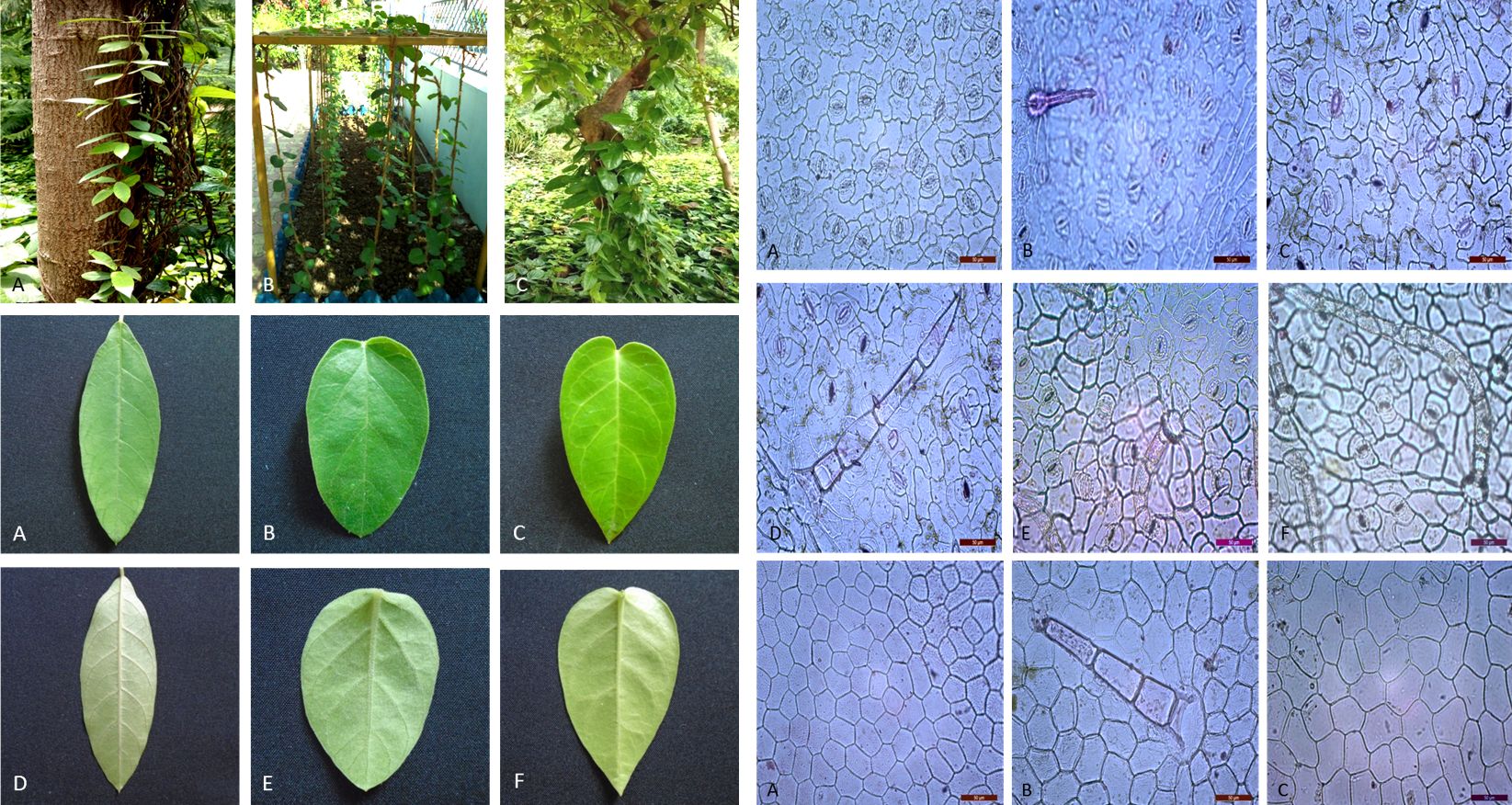Micromorphology studies of three important medicinal plants of Asclepiadaceae family
DOI:
https://doi.org/10.15835/nsb12110528Keywords:
epidermis; foliar characters; Hemidesmus indicus; Leptadenia reticulata; stomatal index; trichome type; Tylophora indicaAbstract
Asclepiadaceae family contains many medicinally important species of which Hemidesmus indicus, Leptadenia reticulata and Tylophora india were selected for the present micromophological studies. It was revealed that different types of stomata like anomocytic, anisocytic and paracytic were present only on abaxial surfaces of leaves. However maximum anomocytic stomata i.e. 25.50±0.43 were observed in L. reticulata followed by H. indicus (24.54±0.31) and T. indica (11.36±0.16). Similarly, observation for trichomes revealed that they were present on abaxial surface in H. indicus and T. indica whereas in L. reticulata on both of the surfaces present. They varied in their type as unicellular in H. indicus whereas multicellular trichomes in L. reticulata and T. indica. This different micromorphological characters will help in identification of authentic plant species.
Metrics
References
Abere TA, Onwukaeme DN (2012). Pharmacognostic evaluation of the leaves of Secamone afzelii (Schult) K Schum (Asclepiadaceae). Tropical Journal of Pharmaceutical Research February 11(1):125-131.
Anonymous (1959). The wealth of India. CSIR Publication, New Delhi, India, pp 162.
Austin A (2008). A review on Indian sarsaparilla, Hemidesmus indicus (L.) R. Br. Journal of Biological Sciences 8(1):1-12.
Bano A, Ahmad M, Zafar M, Sultana S, Khan MA (2015). Comparative foliar micromorphological studies of some species of Asteraceae from alpine zone of Deosai plateau, Western Himalayas. Journal of Animal and Plant Sciences 25(2):422-430.
Bawra B, Dixit M, Chauhan NS, Dixit VK, Saraf DK (2010). Leptadenia reticulata a Rasayana herbs: a review. Asian Journal of Plant Sciences 9:314-319.
Carvalho R, Pellissari LCO, Pace MR, Scremin-Dias EDNA, Arruda RO, Farinaccio MA (2017). Leaf morphoanatomy of Araujia and Morrenia (Asclepiadoideae, Apocynaceae): phylogenetic implications and species key. Botanical Journal of the Linnean Society 183(2):280-293.
El Sayed ZI, Ateya AMM, Fekry M (2012). Macro- and micromorphological study of the leaf, stem, flower and root of Hibiscus rosa-sinensis L. Journal of Applied Sciences Research 8(1):34-56.
Esau K (2002). Anatomy of seed plants. 2nd Ed. John Wiley & Sons, New York.
Fang YM, Fan YW (1993). Variation and evolution of leaf trichomes in Chinese Hammamelidaceae. Journal of Systematics and Evolution 31(2):147-152.
Gupta M, Mukhtar HM, Ahmad S (2010). Phyto-pharmacological and plant tissue culture overview of Tylophora indica (Burm. F.) Merill. Journal of Pharmaceutical Sciences and Research 2:401-411.
Gupta S, George P, Gupta V, Tandon VR, Sundaram KR (1979). Tylophora indica in bronchial asthma-a double blind study. Indian Journal of Medical Research 69:981-989.
Kirtikar KR, Basu BD (1935). Indian medicinal plants. 2nd Ed., vol. I-IV, Dehradun.
Maiti PP, Bhardwaj LK, Agrawal N, Panda S, De B, Mandal SC (2018). Histological evaluation of Calotropis gigantean (L.) R. Br.-leaf, root, stem. Journal of Medicinal Plants 6(4):110-116.
Mammen D, Mammen D, Sane RT (2012). Anatomy and pharmacognosy of Leptadenia reticulata, an important medicinal plant of India. Acta Botanica Hungarica 54(1-2):91-102.
Martin C, Glover BJ (2007). Functional aspects of cell patterning in aerial epidermis. Current Opinion in Plant Biology 10:70-82.
Mohanty SK, Swamy MK, Sinniah UR, Maniyam A (2017). Leptadenia reticulata (Retz.) Wight and Arn. (Jivanti): botanical, agronomical, phytochemical, pharmacological, and biotechnological aspects. Molecules 22:1019.
Neelam, Kumar N, Dwivedi KN, Ram B (2014). Adulteration and substitution of medicinal plant: a burning problem in herbal industry. International Journal of Pharmaceutical & Biological Archives 5(3):13-18.
Puri HS (2003). Rasayana: Ayurvedic herbs for longevity and rejuvenation. Taylor and Francis, London and New York.
Robles-Zepeda RE, Lozoya-Gloria E, Opez MGL, Villarreal ML, Ramirez-Chavez E, Molina-Torres J (2009). Montanoa tomentosa glandular trichomes containing kaurenoic acids chemical profile and distribution. Fitoterapia 80:12-17.
Santhan P (2014). Leaf structural characteristics of important medicinal plant. International Journal of Research in Ayurveda and Pharmacy 5(6):673-679.
Saralla RP, Narendran R, Uma Rani V, Sridharan K, Brindha P (2012). Pharmacognostic standards for diagnosis of Pentatropis capensis (Asclepiadaceae) a plant drug used in Indian system of medicine. International Journal of Pharmacy and Pharmaceutical Sciences 4(2):91-96.
Satheesh K, Remashree AB, Anilkumar N, Balachandran I (2013). Micromorphological studies using scanning electron microscope (SEM) for species delimitation in the selected species of Gymnema occurring in Kerala. International Journal of Herbal Medicine 1(3):5-7.
Schmelzer GH, Gurub-Fakim A, Arroo RRJ (2013). Plant resources of tropical Africa 11. medicinal plants-2. PROTA Foundation: Wageningen, The Netherlands pp 158-159.
Shekhawat MS, Manokari M (2017). Foliar micromorphological evaluation of Cardiospermum halicacabum L.- an important medicinal climber. The Open Plant Science Journal 10:1-9.
Sonibare MA, Oke TA, Soladoye MO (2014). A pharmacobotanical study of two medicinal species of Fabaceae. Asian Pacific Journal of Tropical Biomedicine 4(2):131-136.

Downloads
Published
How to Cite
Issue
Section
License
Papers published in Notulae Scientia Biologicae are Open-Access, distributed under the terms and conditions of the Creative Commons Attribution License.
© Articles by the authors; licensee SMTCT, Cluj-Napoca, Romania. The journal allows the author(s) to hold the copyright/to retain publishing rights without restriction.
License:
Open Access Journal - the journal offers free, immediate, and unrestricted access to peer-reviewed research and scholarly work, due SMTCT supports to increase the visibility, accessibility and reputation of the researchers, regardless of geography and their budgets. Users are allowed to read, download, copy, distribute, print, search, or link to the full texts of the articles, or use them for any other lawful purpose, without asking prior permission from the publisher or the author.













.png)















